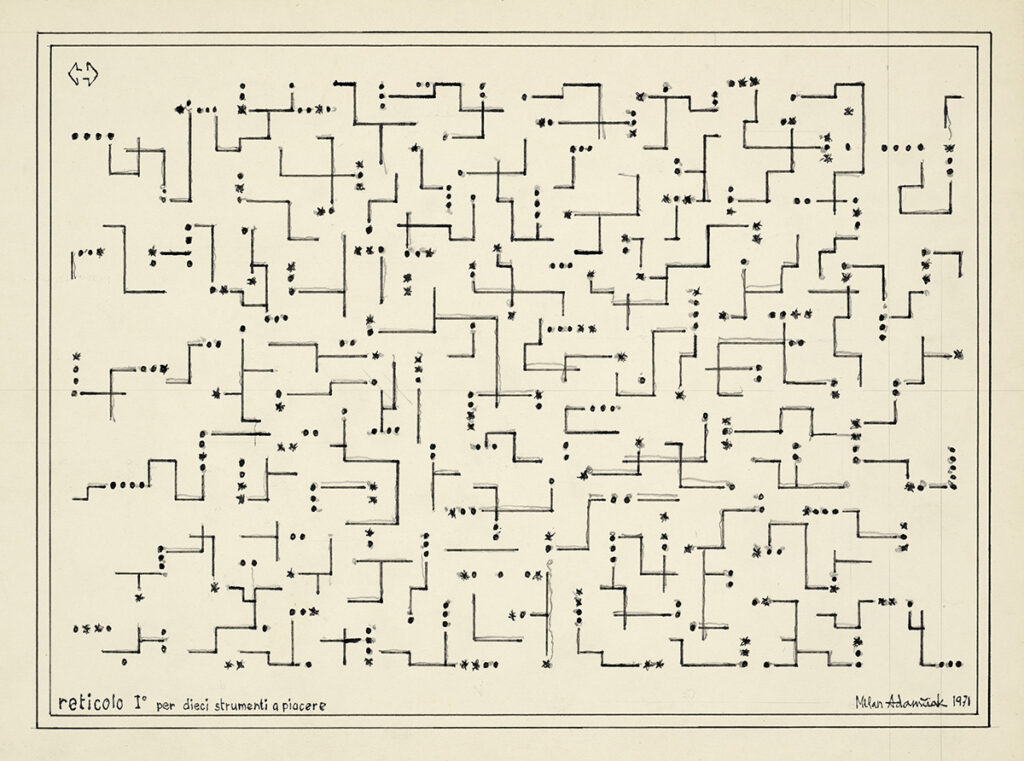The musicologist, cellist and a tireless experimenter Milan Adamčiak was the first one in Slovakia in the 1960s to deliberately dedicate himself to the exploring the overlapping field of intermedia arts – the profound connectionthat has been forged through the medium of music and fine art. Besides this he has started to refer to himself as an author of experimental forms in poetry, graphic and visual partitures, has performed at different music events and performances, as well as created instruments predominantly from found objects.
The title Reticolo I° per dieci strumenti a piacere comes from Italian and refers to the music terminology. Translated as ´a grid (or raster, network structure) I° for ten arbitrary instruments´. It is a visual partiture – a graphic record of a fictive music composition in which the author implies complex relationships between visual and acoustic expression of music working according to the exact mathematical structures. But at the same time, Adamčiak provides the interpretes of this piece of music with great deal of freedom and space for improvisation.
In the work Reticolo I° per dieci strumenti a piacere the viewer can find the junction of visual partiture, experimental poetry and ideas of the movement Fluxus.
The experimental poetry attacks the traditional forms and practices, connects literature, music and visual culture. It is divided into different genres, for example the phonetic poetry (connection of music and literature), concrete poetry (aimed at the simplicity, accuracy, rhythm and mathematical principles), or visual poetry (important is the visual characteristic of the text).
The partiture helps especially with the graphic record of music (notes and scores). Graphic partitures have been used since the 20th century to record other forms of art as well, such as dance, performance or the practices for implementation of different projects. According to the visual graphic partitures a performer doesn´t have to always play them, but they can be supported only in their visual version.
Fluxus (a name taken from a Latin word meaning “to flow”) is an international network of artists, composers and designers (a network Milan Adamčiak belongs to), noted for blending different artistic media and disciplines in the 1960s. They have been active in Neo-Dada noise music and visual art as well as literature, urban planning, architecture, and design. Fluxus is sometimes described as intermedia. The origins of Fluxus lie in many of the concepts explored by composer John Cage in his experimental music of the 1950s which influenced Lithuanian-born artist George Maciunas. Since its beginnings it is closely connected with the experimental music and new theatrical forms.
Milan Adamčiak was born in 1946 in Ružomberok. In 1962-68 he studied cello at the School of Music in Žilina. In 1968-73 he studied musicology at the Faculty of Philosophy at the Comenius University in Bratislava. Since the end of the 1960s he has been working with influential Slovak visual artists (Alex Mlynarčík, Jana Želibská and others) on different group projects and events. He realized (together with Robert Cyprich, Ladislav Kupkovič and Jozef Revall) unique projects and happenings in our environment inspired by John Cage and Fluxus. He established or worked in various intermedia groups, such as SNEH (society for unconventional music) or Transmusic Comp. (with Peter Machajdík, Michal Murin, Zbyňěk Prokop and others).
Omar Mirza
Inventory No.: K-777
Artist: Milan Adamčiak
Title: Reticolo I° per dieci strumenti a piacere
Year of origin: 1971
Technique: ink and pencil drawing
Material: paper
Dimensions: 30 × 42 cm
Signature: bottom left: reticolo I° per dieci strumenti a piacere; bottom right: Milan Adamčiak 1971;
